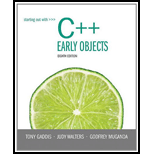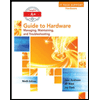
Starting Out with C++: Early Objects
8th Edition
ISBN: 9780133360929
Author: Tony Gaddis, Judy Walters, Godfrey Muganda
Publisher: Addison-Wesley
expand_more
expand_more
format_list_bulleted
Concept explainers
Expert Solution & Answer
Chapter 1.2, Problem 1.6CP
Explanation of Solution
Main memory:
Main memory or Random Access Memory (RAM) is the volatile memory which means the information stored in that memory would be erased when the computer is turned off.
- Main memory has a limited storage capacity so it cannot store a large amount of data.
- The data or information stored in the main memory is directly accessed by the Central Processing Unit (CPU).
Example:
Some of the examples of main memory are,
- RAM (Random Access Memory).
- ROM (Read Only Memory).
- EPROM (Erasable Programmable Read Only Memory).
- PROM (Programmable Read Only Memory).
- Cache memory.
- Registers.
Secondary storage:
- Secondary storage or secondary memory is the non-volatile memory which means the information stored in that memory cannot be erased even when there is any mishap in the computer...
Expert Solution & Answer
Want to see the full answer?
Check out a sample textbook solution
Students have asked these similar questions
Dijkstra's Algorithm (part 1). Consider the network shown below, and Dijkstra’s link-state algorithm. Here, we are interested in computing the least cost path from node E (note: the start node here is E) to all other nodes using Dijkstra's algorithm. Using the algorithm statement used in the textbook and its visual representation, complete the "Step 0" row in the table below showing the link state algorithm’s execution by matching the table entries (i), (ii), (iii), and (iv) with their values. Write down your final [correct] answer, as you‘ll need it for the next question.
4. |z + 5 - 5i| = 7
14.
dz,
C: |z❘
C: |z❘ = 0.6
ze² - 2iz
H
Chapter 1 Solutions
Starting Out with C++: Early Objects
Ch. 1.2 - Why is the computer used by so many different...Ch. 1.2 - List the five major hardware components of a...Ch. 1.2 - Internally, the CPU consists of what two units?Ch. 1.2 - Prob. 1.4CPCh. 1.2 - Prob. 1.5CPCh. 1.2 - Prob. 1.6CPCh. 1.2 - What are the two general categories of software?Ch. 1.2 - Prob. 1.8CPCh. 1.2 - What do you call a program that performs a...Ch. 1.2 - Word processing programs, spreadsheet programs,...
Ch. 1.3 - What is an algorithm?Ch. 1.3 - Why were computer programming languages invented?Ch. 1.3 - Prob. 1.13CPCh. 1.3 - Prob. 1.14CPCh. 1.3 - Prob. 1.15CPCh. 1.3 - Prob. 1.16CPCh. 1.3 - Prob. 1.17CPCh. 1.5 - Describe the difference between a key word and a...Ch. 1.5 - Prob. 1.19CPCh. 1.5 - Prob. 1.20CPCh. 1.5 - Prob. 1.21CPCh. 1.5 - Prob. 1.22CPCh. 1.5 - What must take place in a program before a...Ch. 1.5 - Prob. 1.24CPCh. 1.6 - What four items should you identify when defining...Ch. 1.6 - Prob. 1.26CPCh. 1.6 - Prob. 1.27CPCh. 1.6 - What is pseudocode?Ch. 1.6 - What is the difference between high-level...Ch. 1.6 - Describe what a compiler does with a programs...Ch. 1.6 - Prob. 1.31CPCh. 1.6 - Prob. 1.32CPCh. 1.6 - Prob. 1.33CPCh. 1 - Computers can do many different jobs because they...Ch. 1 - The job of the _____ is to fetch instructions,...Ch. 1 - Internally, the CPU consists of the _____ and the...Ch. 1 - Prob. 4RQECh. 1 - The two general categories of software are _____...Ch. 1 - Prob. 6RQECh. 1 - Since computers cant be programmed in natural...Ch. 1 - _____is the only language computers really...Ch. 1 - Prob. 9RQECh. 1 - Prob. 10RQECh. 1 - A programs ability to run on several different...Ch. 1 - Words that have special meaning in a programming...Ch. 1 - Prob. 13RQECh. 1 - _____ are characters or symbols that perform...Ch. 1 - _____ characters or symbols mark the beginning or...Ch. 1 - Prob. 16RQECh. 1 - A(n) _____ is a named storage location.Ch. 1 - A variable must be _____ before it can be used in...Ch. 1 - The three primary activities of a program are...Ch. 1 - _____ is information a program gathers from the...Ch. 1 - _____ is information a program sends to the...Ch. 1 - A(n) _____ is a diagram that graphically...Ch. 1 - Prob. 23RQECh. 1 - What is the difference between system software and...Ch. 1 - Prob. 25RQECh. 1 - Prob. 26RQECh. 1 - Account Balance Write high-level and detailed...Ch. 1 - Sales Tax Write high-level and detailed pseudocode...Ch. 1 - The variable sum starts with the value 0. Add 10...Ch. 1 - The variable x starts with the value 0. The...Ch. 1 - The variable j starts with the value 10. The...Ch. 1 - The variable a starts with the value 1. The...Ch. 1 - Find the Error 33. The following pseudocode...Ch. 1 - Suppose one of your friends, who paints the...Ch. 1 - Candy Bar Sales Using Program 1-1 as an example,...Ch. 1 - Baseball Costs Using Program 1-1 as an example,...
Knowledge Booster
Learn more about
Need a deep-dive on the concept behind this application? Look no further. Learn more about this topic, computer-science and related others by exploring similar questions and additional content below.Similar questions
arrow_back_ios
SEE MORE QUESTIONS
arrow_forward_ios
Recommended textbooks for you
 Enhanced Discovering Computers 2017 (Shelly Cashm...Computer ScienceISBN:9781305657458Author:Misty E. Vermaat, Susan L. Sebok, Steven M. Freund, Mark Frydenberg, Jennifer T. CampbellPublisher:Cengage Learning
Enhanced Discovering Computers 2017 (Shelly Cashm...Computer ScienceISBN:9781305657458Author:Misty E. Vermaat, Susan L. Sebok, Steven M. Freund, Mark Frydenberg, Jennifer T. CampbellPublisher:Cengage Learning Principles of Information Systems (MindTap Course...Computer ScienceISBN:9781285867168Author:Ralph Stair, George ReynoldsPublisher:Cengage Learning
Principles of Information Systems (MindTap Course...Computer ScienceISBN:9781285867168Author:Ralph Stair, George ReynoldsPublisher:Cengage Learning A+ Guide to Hardware (Standalone Book) (MindTap C...Computer ScienceISBN:9781305266452Author:Jean AndrewsPublisher:Cengage Learning
A+ Guide to Hardware (Standalone Book) (MindTap C...Computer ScienceISBN:9781305266452Author:Jean AndrewsPublisher:Cengage Learning Principles of Information Systems (MindTap Course...Computer ScienceISBN:9781305971776Author:Ralph Stair, George ReynoldsPublisher:Cengage Learning
Principles of Information Systems (MindTap Course...Computer ScienceISBN:9781305971776Author:Ralph Stair, George ReynoldsPublisher:Cengage Learning Systems ArchitectureComputer ScienceISBN:9781305080195Author:Stephen D. BurdPublisher:Cengage Learning
Systems ArchitectureComputer ScienceISBN:9781305080195Author:Stephen D. BurdPublisher:Cengage Learning Fundamentals of Information SystemsComputer ScienceISBN:9781337097536Author:Ralph Stair, George ReynoldsPublisher:Cengage Learning
Fundamentals of Information SystemsComputer ScienceISBN:9781337097536Author:Ralph Stair, George ReynoldsPublisher:Cengage Learning

Enhanced Discovering Computers 2017 (Shelly Cashm...
Computer Science
ISBN:9781305657458
Author:Misty E. Vermaat, Susan L. Sebok, Steven M. Freund, Mark Frydenberg, Jennifer T. Campbell
Publisher:Cengage Learning

Principles of Information Systems (MindTap Course...
Computer Science
ISBN:9781285867168
Author:Ralph Stair, George Reynolds
Publisher:Cengage Learning

A+ Guide to Hardware (Standalone Book) (MindTap C...
Computer Science
ISBN:9781305266452
Author:Jean Andrews
Publisher:Cengage Learning

Principles of Information Systems (MindTap Course...
Computer Science
ISBN:9781305971776
Author:Ralph Stair, George Reynolds
Publisher:Cengage Learning

Systems Architecture
Computer Science
ISBN:9781305080195
Author:Stephen D. Burd
Publisher:Cengage Learning

Fundamentals of Information Systems
Computer Science
ISBN:9781337097536
Author:Ralph Stair, George Reynolds
Publisher:Cengage Learning